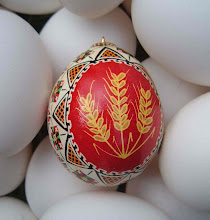Thursday, May 20, 2010
Japanese Beetle Larva
This ugly grub is what the Japanese Beetle looks like at this stage. Notice how large it is - much larger than the Japanese Beetle itself. It's these larvae that eat the roots of grass in lawns and destroy large patches. Reseeding is only moderately successful if there's an infestation of the Beetles, because these voracious grubs will hatch each year.
About 35 years ago my family had a significant Japanese Beetle problem, and we treated both our back and front lawns with Milky Spore disease, which kills most of the larvae. Enough survive to carry on the disease, and it's only been in the last 3 or 4 years that I've seen any Japanese Beetles in my yard again. So it solved our problem for 30 years. It's moderately expensive, but only needs to be applied once. Just google the disease and you'll find tons of sources and information. I'm pretty sure the local garden centers have it too.
Ideally, neighbors would treat their lawns too, but the nature of the disease is that over time it will infect enough larvae so the numbers in the neighborhood will be reduced. We treated only our lawn, but it was still very effective. Milky Spore Disease is not a short-term solution for the garden, and is only to be applied to lawns, not gardens, anyway.
Japanese beetles have become more and more of a problem in the community gardens (from which I collected this specimen a couple of days ago), where there are large dead patches of lawn adjacent to the gardens. They are notorious lovers of zinnias, and so zinnias can be used as a trap crop. In other words, you can grow some sacrificial zinnias to protect other nearby plants that they might like, and you can collect the beetles from the zinnias. Evening primrose (a weed) also serves as a trap crop. The food crop they attacked most were the snap peas. In the garden I knock the adults into soapy water (don't try plain water!) The container of soapy water needs to be positioned under the beetles, since they tend to drop as soon as disturbed, so it's not easy to pick them up.
You may also see miniature versions of this larva, about 1/4 to 1/2 inch in width, and these are the larvae of the masked chafer beetle, related to the Japanese beetle. The brown chafer eats roots of plants in the garden and is a more significant pest than we're usually aware of, because they're usually at ground level. When digging in the spring you may find little nests of these larvae.
These are both related to what I grew up calling June bugs or May beetles (saw one in April this year). These are shaped like the other chafers, but are much larger, with a dark brown shell. They are not a significant pest for us in the garden.
Subscribe to:
Post Comments (Atom)




No comments:
Post a Comment